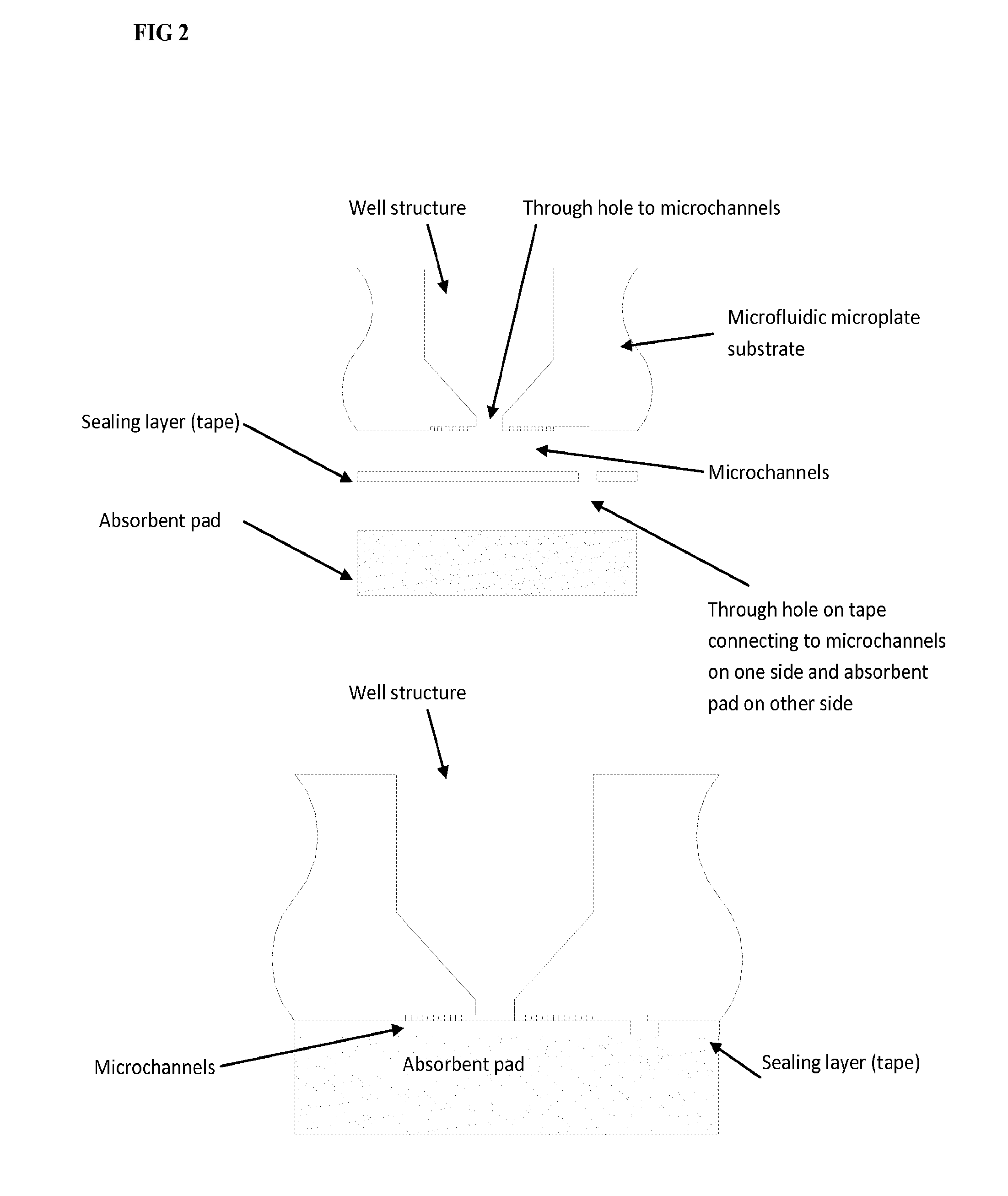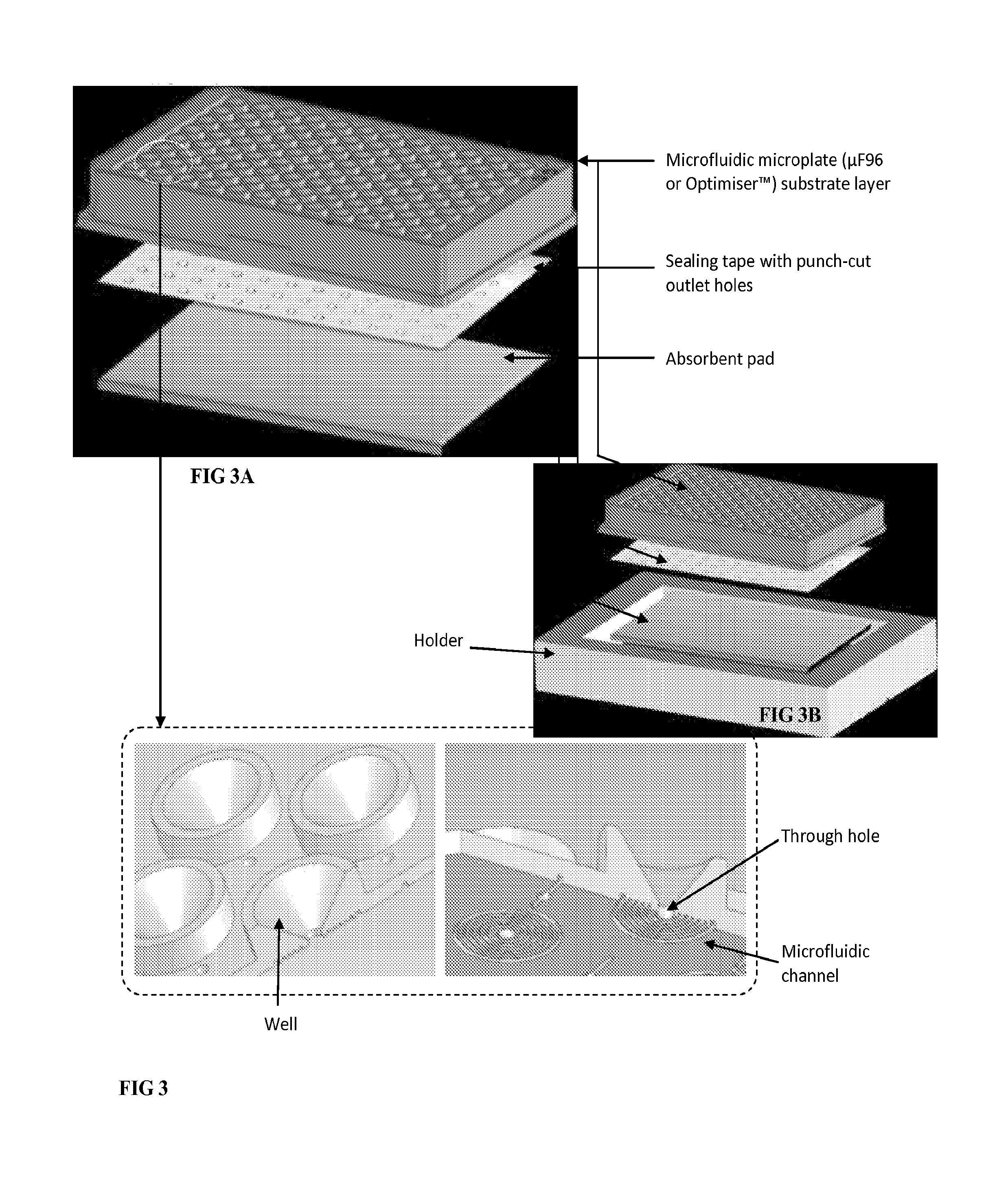Microfluidic assay devices and methods
- Summary
- Abstract
- Description
- Claims
- Application Information
AI Technical Summary
Benefits of technology
Problems solved by technology
Method used
Image
Examples
case study 1
rocedure for Conventional 96-Well Plate
[0200]1) Add 100 μl Capture Antibody Solution into each well, seal plate, and incubate at 37° C. for 1.5 hours.[0201]2) Wash the plate with PBS (T-20), 2 times and followed by PBS, 3 times.[0202]3) Add 300 μl Blocking Buffer into each well, seal plate, and incubate at 37° C. for 1.5 hours.[0203]4) Repeat Step 2.[0204]5) Pipette 100 μl of each prepared standards, controls and / or samples into appropriate wells, seal the plate with film, and incubate at 37° C. for 1.5 hours.[0205]6) Repeat Step 2.[0206]7) Add 100 μl of Detection Antibody Solution into each well, seal the plate with film, and incubate at 37° C. for 1.5 hours.[0207]8) Repeat Step 2.[0208]9) Add 100 μl of SAv-HRP Solution into each well, seal the plate with film, and incubate at 37° C. for 1.5 hours.[0209]10) Repeat Step 2.[0210]11) Add 100 μl of the Ultra-TMB Substrate Solution per well, incubate plate at room temperature for 15 minutes, stop reaction by adding 50 μl of 2 N sulfuric...
case study 2
Assay Protocol for 10 μl (Static) and 90 μl and 270 μl (Flow-Through) Run for IL-6
[0222]1) Assemble Optimiser™ plate with absorbent pad and holder. Prime the Optimiser™ plate with the PBS based priming buffer as described herein.[0223]2) Add 10 μl of capture antibody solution into each well, and incubate at room temperature for 10 minutes.[0224]3) Add 10 μl of blocking buffer into each well, and incubate at room temperature for 10 minutes.[0225]4) For static mode: Prepare the standard solution with concentration in range of 2-500 pg / ml with zero, pipette 10 μl of each prepared standard solution into appropriate wells, and incubate at room temperature for 10 minutes*.[0226]For flow-through mode (90 μl): Prepare the standard solution with concentration in range of 0.4-100 pg / ml with zero, pipette 30 μl of each prepared standard solution into appropriate wells, wait for 10 minutes, repeat three times, 90 μl of total volume was loaded into each well.[0227]For flow-through mode (270 μl):...
case study 3
of Coat Buffer on Optimiser™ Assay Performance
[0237]Assay screening with coating buffers at pH in range from 5.0 to 10.5.
[0238]Unlike the assay in conventional plate, the capture antibody adsorption in Optimiser™ is dominated by the reaction rate of protein adsorption, which is strongly affected by the ingredients of coating buffer. A coating buffer screening test with pH in range from 5.0 to 10.5 has been performed with various assays.
Coating buffer: Phosphate citrate buffer, pH at 5.0 and 5.5; PBS buffer, pH at 6.0, 6.5, 7.0, 7.5;
Tris buffer, pH at 8.0, 8.5, 9.0; and Carbonate-Bicarbonate buffer, pH at 9.5, 10.0, 10.5
[0239]Experiment: follow the standard protocol described previously, no priming step, dilute the capture antibody with buffers above, one wash step after capture antibody incubation, using one concentration for each antigen.
Results:
[0240]Assay response profile with coating buffer at pH in range from 5.0 to 10.5.
[0241]Conclusion: All assays shows better dose response i...
PUM
 Login to View More
Login to View More Abstract
Description
Claims
Application Information
 Login to View More
Login to View More - R&D
- Intellectual Property
- Life Sciences
- Materials
- Tech Scout
- Unparalleled Data Quality
- Higher Quality Content
- 60% Fewer Hallucinations
Browse by: Latest US Patents, China's latest patents, Technical Efficacy Thesaurus, Application Domain, Technology Topic, Popular Technical Reports.
© 2025 PatSnap. All rights reserved.Legal|Privacy policy|Modern Slavery Act Transparency Statement|Sitemap|About US| Contact US: help@patsnap.com



